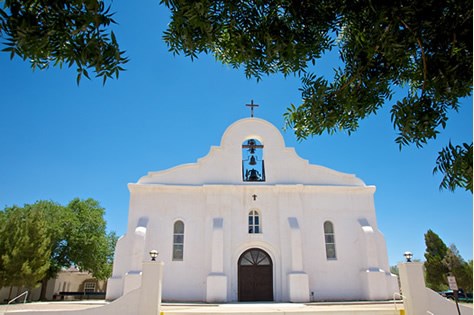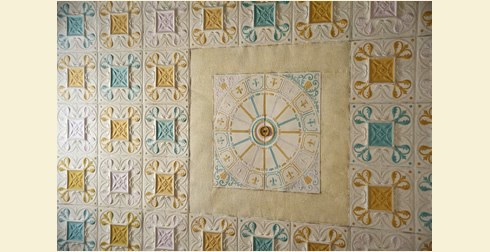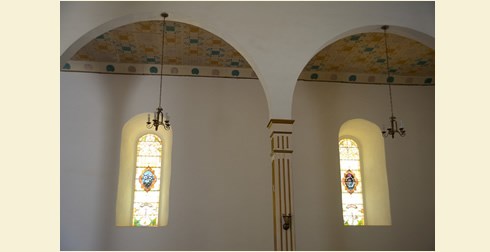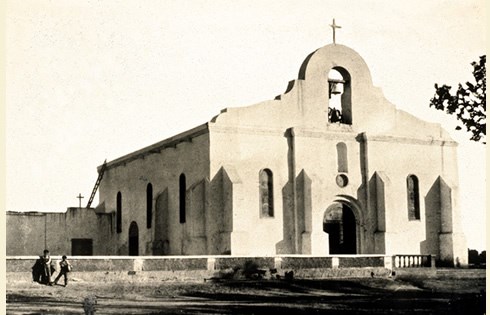Last updated: July 2, 2020
Article
Texas: Presidio Chapel of San Elizario

The curved espadaña (belfry) of the Presidio Chapel of San Elizario looms above the West Texas horizon with the elegant air of the architectural tradition of the Iberian Peninsula. Though it was an early 20th-century addition, the bell tower brings a soft contrast to the hard-edged history of San Elizario, a West Texas frontier community on El Camino Real de Tierra Adentro. Constructed between 1877 and 1882, the chapel was the fourth to be built at San Elizario’s former military presidio. Now occupying the heart of the San Elizario Historic District, the chapel has outlasted floods, fire, rogue Apaches and the threats of modern development to stand as one of the most significant survivors of the presidio’s dramatic past.
Located about 17 miles southeast of El Paso on a stretch of El Camino Real known locally as the Mission Trail, San Elizario marks the start of the northbound trail in the U.S. as it moves across the Rio Grande out of Mexico, through the lower El Paso Valley, and into New Mexico. In 1788, the site was the chosen spot to locate a strategic military stronghold on New Spain’s western frontier. Soldiers from San Elzeario (also San Elceario), a decommissioned Spanish fort in Guajoquilla, Mexico (present-day Chihuahua), occupied the new presidio to defend area residents and El Camino Real caravans from Apaches. Like the fort it replaced, the new presidio was named in honor of San Elzear, the French patron saint of soldiers.
The presidio took shape as a formidable, high-walled adobe fortress accessed by El Camino Real. At its center, built to serve Spanish soldiers and their families, was the adobe chapel of Nuestra Señora del Pilar y de Gloriosa San José (Our Lady of Pilar and Glorious St. Joseph). Nothing was stable on the Rio Grande floodplain, however, and in 1829, the latest deluge in a centuries-long string of devastating floods swept through San Elzeario, destroying the presidio chapel. The torrent also carved a new river channel that set San Elzeario on the Rio Grande’s north side.

Residents looked to higher ground before rebuilding the church, and by 1841, a new chapel served a town of more than 1,000 residents. By the time U.S. troops occupied the presidio from 1847 through the end of the Mexican-American War, community neglect and ongoing floods had damaged the chapel again. Still another flood in 1852 left the chapel and presidio in ruins. Residents salvaged part of their adobe remains to construct a small temporary church that served until 1877, when a new chapel rose again. Now part of Texas, San Elzearo was commonly known as San Elizario.
Built just south of the San Bernal Plaza, the community’s spiritual hub took shape in traditional architectural fashion with thick adobe walls, massive buttresses and a flat viga (ceiling beam) roof. The chapel’s single-nave design moved purposefully toward a central altar, while tall, narrow, arched windows reached toward a triangular bell tower atop the facade. Simple, straightforward and largely unembellished, the chapel initially replicated the modest, box-like model of early Southwest mission architecture, though technically San Elizario was not part of the mission system. As the Territorial period moved into the 20th century, the introduction of new European elements brought the chapel to its current Spanish Colonial Revival style.
Among the most notable of the changes was the alteration of the triangular espadaña to a rounded bell tower set into a decorative curvilinear parapet. More dramatic alterations followed a 1935 electrical fire that gutted chapel interiors. A pressed tin ceiling was installed over traditional vigas and plain wood column supports were replaced by ornate neoclassical posts. Pictorial stained glass windows combined religious and patriotic images from the Sacred Heart to the Star of Texas. Later, in the 1940s, local World War II soldiers were honored in a specially designed area at the rear of the church. This would expand over time to include plaques with names of area veterans who died in service to their country in other wars.

Miraculously, the fire that destroyed the inner chapel left the exterior walls largely intact. This allowed the chapel to retain its 1877 framework as the spiritual heart of San Elizario. El Camino Real remained part of San Elizario’s physical and cultural landscape until the railroad bypassed the community in the late 19th century. El Camino Real lost its commercial luster, and San Elizario returned to its quiet rural roots.
Today, the presidio chapel continues to anchor San Elizario as an active parish. Four vertical bells and four horizontal buttresses bring an imposing symmetry to the relatively small building, which is set in a frame of low masonry walls and a dramatic sweep of front steps. The stark white building paints a picture of purity and stability in an ever-changing world. Despite centuries of change, El Camino Real, today’s Glorieta Road, still leads residents and visitors to and from the chapel at the old presidio.
The Presidio Chapel of San Elizario is located at 1556 San Elizario Rd. in San Elizario, TX. The wheelchair-accessible mission is open to the public Monday through Friday from 7:00am to 11:00am. Pre-arranged tours are encouraged. Visitation is also welcome at the shrine to the Virgin Mary outside of the church. For more information on visitation or tours, visit the Los Portales Museum and Information Center website or call 915-851-1682.
The Presidio Chapel of San Elizario has been documented by the National Park Service's Historic American Buildings Survey.
Explore more history by visiting the El Camino Real travel itinerary website.

